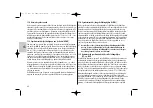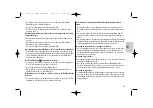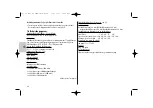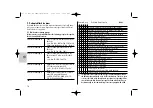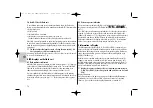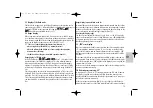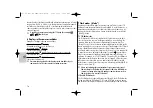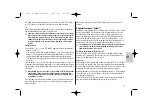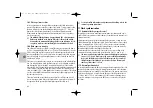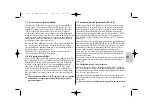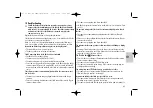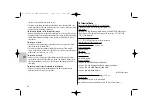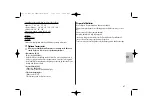
73
ķ
5.1 Display of the flash mode
The flash mode set appears in the display. Depending on the camera model or
camera group (see Table 1), different displays are possible in this connection for
the various TTL flash modes supported (for example,
,
BL,
,
BL) and the manual flash mode M, see 7).
5.2 Range display
When using cameras from Groups B, C, D and E and a lens with CPU, the ran-
ge is indicated in the display. For this a data exchange must have occurred bet-
ween the camera and flash unit, for example by tapping the shutter release. The
range can be displayed either in metres (m) or feet (ft) - see 9.7.
There is no range display with cameras from Group A, or
- when using lenses without CPU (e.g. manual focus lens).
- when the reflector head is tilted out of its normal position (upwards,
downwards or sideways).
- the flash unit is working in remote flash operation (slave SL).
Range display in TTL flash modes
In the TTL flash modes (
,
BL,
,
BL; see 7.1) the value for the
maximum range of the flash unit is displayed. The value indicated relates to
subjects with a reflection factor of 25%, which applies to most photographic
situations. Strong deviations from this reflection factor, as in the case of highly
reflective or poorly reflective subjects, may affect the flash range of the flash
unit.
The subject ought to be in the area of approximately 40% to 70% of the value
displayed. This will give the automatic exposure control sufficient scope for com-
pensation. To avoid overexposure, the minimum distance should be no less than
10% of the indicated value! Adjustment to the photographic situation at hand
can be achieved by, for example, changing the aperture of the setting on the
lens.
TTL
TTL
TTL
TTL
☞
TTL
TTL
TTL
TTL
Range display in manual flash mode M
In manual flash mode M, the distance that must be maintained from the subject
for correct flash exposure is indicated. Adjustment to the photographic situation
at hand can be achieved by, for example, changing the aperture setting on the
lens or selecting a manual partial light output level (see 7.2).
Exceeding the display range
The flash unit can indicate flash ranges of up to 199 m or 199 ft. This display
range can be exceeded in the case of high ISO values (e.g., ISO 6400) and lar-
ge aperture openings. An arrow or triangle after the distance value indicates
that the display range has been exceeded.
5.3 „FEE“ error display
On some camera models and/or some camera modes (for example, program
„P“, vari-programs, automatic aperture S), it is necessary to set the aperture
ring of the lens to the maximum f-number. Otherwise the error message „FEE“
will appear on the flash unit or camera and the camera shutter release will be
blocked!
Some camera models do not support the manual flash mode M in the camera
mode program P and the vari- or subject programs. If the flash mode M is selec-
ted in these camera modes, „FEE“ appears in the display as a warning and the
camera release is locked.
If this occurs, check the settings on the camera and/or the lens settings (see the
camera’s operating instructions).
5.4 Underexposure warning „EV“
In certain modes („P“ and „A“, for example) some Group C, D and E cameras
(see Table 1) respond to an underexposed flash shot with a warning on the
display of the flash unit, indicating the amount of underexposure in f-stops (see
the camera’s operating instructions).
If the correct exposure indication „OK“
does not light up on the flash unit
after a flash shot is taken, or if the flash symbol blinks in the camera viewfinder,
707 47 0081.A2 48AF-1Nikon/Inh. 19.09.2007 12:42 Uhr Seite 73




